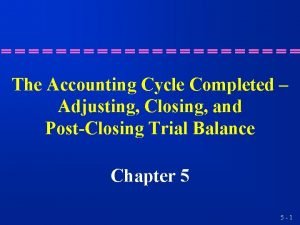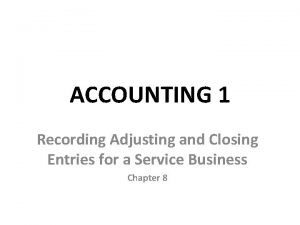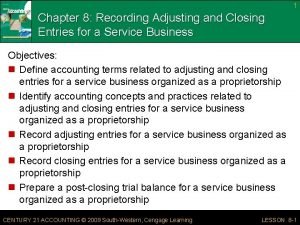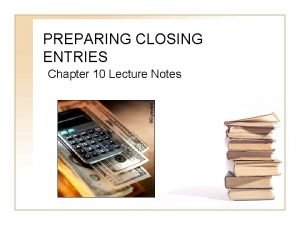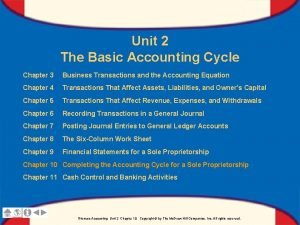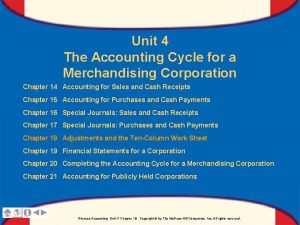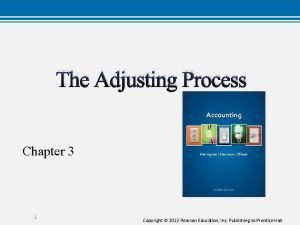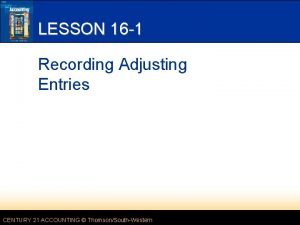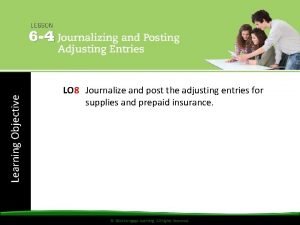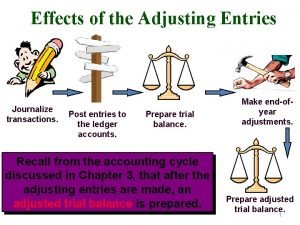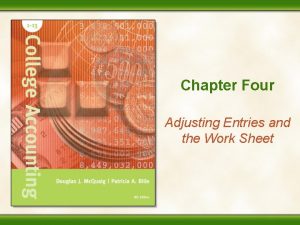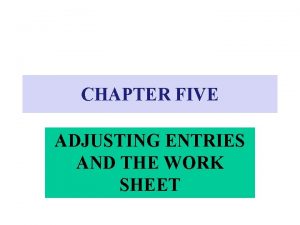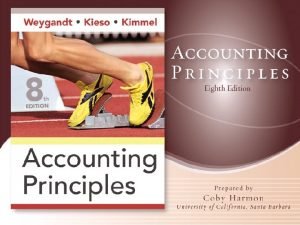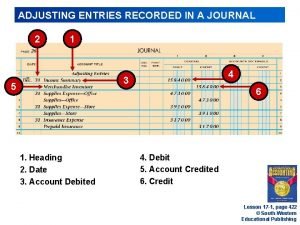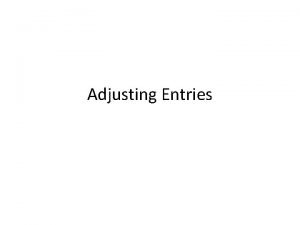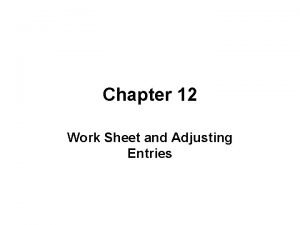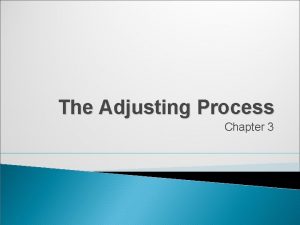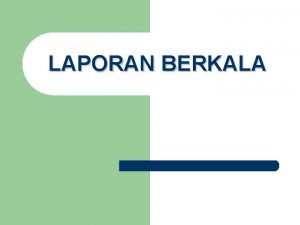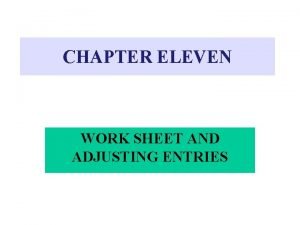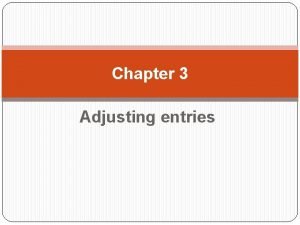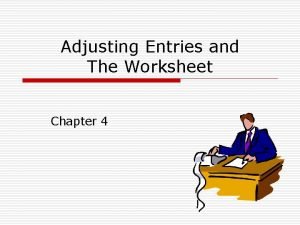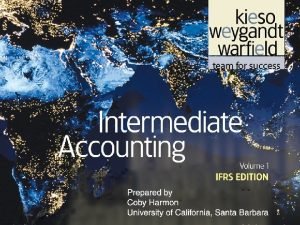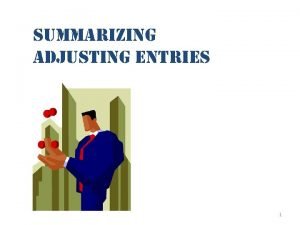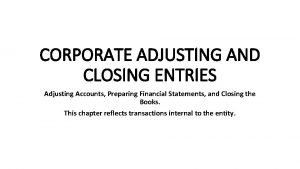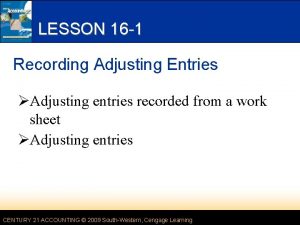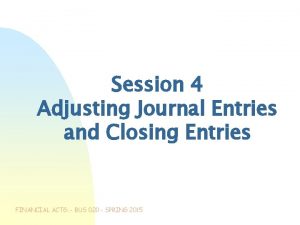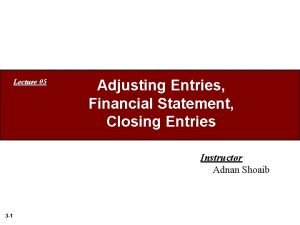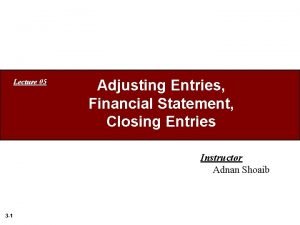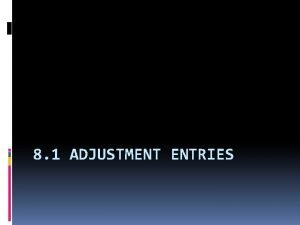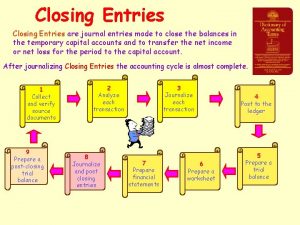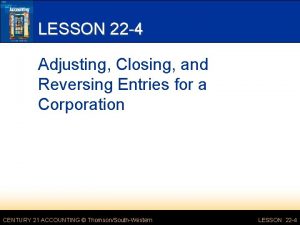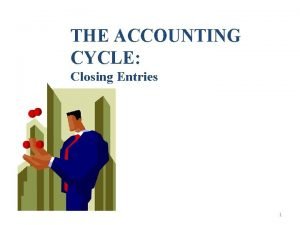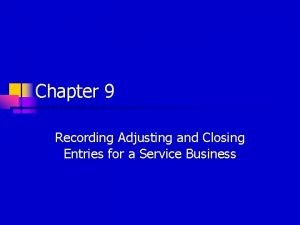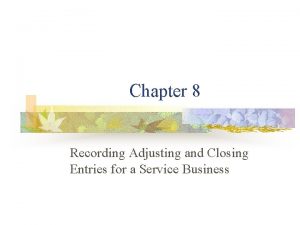CORPORATE ADJUSTING AND CLOSING ENTRIES Adjusting Accounts Preparing





















- Slides: 21

CORPORATE ADJUSTING AND CLOSING ENTRIES Adjusting Accounts, Preparing Financial Statements, and Closing the Books. This chapter reflects transactions internal to the entity.

Underlying GAAP Considerations • Time Period Assumption • The time period assumption presumes the company can adequately prepare its financial statements when its accounting periods are divided into months or years. Timely information is paramount to good decisions. Additionally, owners periodically want to know the amount of their wealth accumulation. The books of the company will be brought up to date as of a specific date. • Accrual basis of accounting • GAAP requires companies to match expenses to revenue. And revenue to be recognized when earned. Thus, when the books must be closed as of a specific date, all expenses and revenues must be brought up to date. The updating of expenses and revenue flow from internal transactions which remain unrecorded until the books are “adjusted. ” These internal transactions are called “adjusting journal entries” and are therefore different form journal entries which flow from external transactions. • Recognizing Revenues and Expenses • The revenue recognition principle requires that revenue be recorded when earned. Companies earn revenue when they provide services and products to customers. A major goal of the adjusting process is recognize revenue in the time period when it is earned not when they paid. • The expense recognition (or matching) principle aims to record expenses in the same accounting period as the revenues that are earned as a result of those expenses. This matching of expenses with the revenue benefits is a major part of the adjusting process. • The cash basis of accounting recognizes transactions when cash/credit is exchanged.

Adjusting Journal Entries We will learn about six adjustments to bring the books up to date. • Prepaid expenses • Unearned revenue • Supplies • Depreciation • Accrued expenses • Accrued revenues - Not emphasized Adjusting entries are necessary so that revenues, expenses, assets, and liabilities are correctly reported. Specifically, an adjusting entry is made at the end of an accounting period to reflect a transaction or event that is not yet recorded through transactions with external parties. Each adjusting entry affects one or more income statement accounts and one or more balance sheet accounts (but never the Cash account).

Prepaid Expenses Prepaid expenses refer to cash paid in advance of receiving a product or service. • They reflect transactions for more than one period of time and are therefore not expenses. • When these assets are used, their costs become expenses. If one company records a prepaid expense, the company who received the money records unearned revenue. • In our chapter example, the company prepaid insurance in the amount of$2, 400 for 24 months of insurance benefits that began on December 1. • With the passage of time, the benefits of the insurance gradually expire and a portion of the Prepaid Insurance asset becomes expense. • For instance, one month’s insurance coverage expires by December 31. This expense is $100, or 1/24 of $2, 400, which leaves $2, 300 as an account balance. The adjusting entry to record this expense and reduce the asset, along with T-account postings. • The December 1 transaction is an external journal recognizing the prepayment of the insurance. • The December 31 transaction is the adjusting journal entry recognizing the passage of time when the company used this coverage. • If the company asks for a refund on December 31, it would receive $2, 300 not $2, 400.

Unearned (Deferred) Revenues The term unearned revenues refers to cash received in advance of providing products and services. • Unearned revenues are liabilities. • When cash is accepted, an obligation to provide products or services is incurred. • As products or services are provided, the unearned revenues become earned revenues. • Adjusting entries for unearned revenues involve increasing revenues and decreasing unearned revenues. • Remember, the company receiving the money has unearned revenue and the one paying the money records a prepaid asset. The company received $3, 000 on Dec 26 in advance for consulting work to be done over the next sixty (60) days. The company is now obligated to perform the consulting work or pay back the money back. • This journal entry records the receipt of the money on Dec 26 • As time passes and work is done, the company works on this contract through consulting. By December 31, it has provided five days’ service. • Revenue recognition principle implies that $250 of unearned revenue must be reported as revenue on the December income statement because the company has partially performed its obligation. If the client were to ask for a refund, the $250 would be deducted from the amount due since it has been earned. • The adjusting entry to reduce the liability account and recognize earned revenue, along with T-account postings, follows:

Office Supplies are an asset which will be used up over time. This usage creates an expense to be matched against the revenues they helped to generate. In our chapter example, the company purchased $9, 720 of supplies in December and some of them were used during this month. When financial statements are prepared as of December 31, the cost of supplies used during December must be recognized. • When the company takes physical count of its remaining, unused supplies at December 31, it finds $8, 670 of supplies on hand. This means of the $9, 720 total supplies, $1, 050 ($9, 720 minus $8, 670) must have been used by company employees in the month of December. This is December’s supply expense and requires an adjusting journal entry. • The adjusting entry to record this expense and reduce the Supplies asset account, along with T-account posting

Depreciation Plant assets refer to long-term tangible assets used to produce and sell products and services. Plant assets are expected to provide benefits for more than one period. Examples of plant assets are buildings, machines, vehicles, and fixtures. Depreciation is the process of allocating the costs of these assets over their expected useful lives —amount of time the company will use the asset to produce income. Depreciation expense is recorded with an adjusting entry Equipment was purchased for $26, 000 in early December for use in operations. This equipment’s cost must be allocated to future periods it benefits and “depreciated. ” • The equipment is expected to have a useful life (benefit period) of four years and to be worth about $8, 000 at the end of four years. • The company uses a method called straight-line depreciation, which allocates equal amounts of the asset’s net cost to depreciation during its useful life. • The adjusting entry to record monthly depreciation expense, along with T-account postings.

Accumulated Depreciation Accumulated depreciation (a balance sheet account) is recorded in a separate contra account. A contra account is an account linked with another account, where the contra account has a normal balance opposite of the account it is linked with. It is reported as a subtraction from that other account’s balance on the Balance Sheet. This account will “accumulate” depreciation until either fully depreciated or the asset is removed from the books. • The contra account of Accumulated Depreciation is subtracted from the Equipment account on the Balance Sheet. • This contra account allows balance sheet readers to know both the full costs of assets and the total accumulated depreciation. • This is our first exception to the debit and credit rules. Accumulated depreciation is an asset account that increased with a credit. • It is placed among the assets and is part of total assets on the balance sheet. • The title of the contra account, Accumulated Depreciation, reveals that this account includes total amount of depreciation for all prior periods. • Accumulated depreciation gives financial statement readers a lot of information. Which company has newer assets?

Accruals Heretofore, we have adjusted accounts and amounts already in existence but accruals reflect necessary adjustments that have not yet been recorded. Accrued expenses. Costs such as wages, interest, utilities that have not yet been recorded but are known and due. Each type of expenses has contributed to the company’s ability to earn revenue. They have been incurred but not yet paid. • Supposed an employee earns $70 per day. • A company must record wage expense for all employees from the last payroll to the date of the financial statements. • Thus, if an employee has worked three days since last payroll and the financial statements are prepared as of Dec 31, then

Accrued Revenues The term accrued revenues refers to revenues earned in a period that are both unrecorded and not yet received in cash (or other assets). Usually recognized as the result of a contract or otherwise enforceable agreement such as bank interest. • If a company earns a portion of the income associated with a contract, companies often recognize the amount earned but not yet paid. If there is a $2, 700 contract for 30 days and the company has worked on it for 20 days, then

Adjusted Trial Balance After the adjusting journal entries are recorded, a company runs an adjusted trial balance. An unadjusted trial balance is a list of accounts and balances prepared before adjustments are recorded. An adjusted trial balance is a list of accounts and balances prepared after adjusting entries have been recorded and posted to the ledger thus contains external and internal transactions. The adjusted trial balance is the second of the three (3) trial balances prepared by a company. • The order of accounts in the trial balance is usually set up to match the order in the chart of accounts. • Usually they are numbered based upon liquidity and whether the accounts reflect current or long-term items. • Several new accounts arise from the adjusting entries.

PREPARING FINANCIAL STATEMENTS • We can prepare financial statements directly from information in the adjusted trial balance. An adjusted trial balance includes all accounts and balances in the financial statements and is easier to work from than the entire general ledger when preparing financial statements. • We prepare financial statements in the following order: Income Statement, Statement of Retained Earnings, and Balance Sheet. The Income Statement information is needed to prepare the Statement of Retained Earnings. The information from the Statement of Retained Earnings is used to prepare the Balance Sheet.

The general ledger does not agree with the financial statements until closing entries are made. The general ledger balance of $0 does not agree to the financial statements until the closing entries are made to updated RE.

CLOSING PROCESS After financial statements have been finalized, it is time to close the books. • The closing process is an important step at the end of an accounting period after financial statements have been completed. The financial statements have been prepared and now journal entries called “closing” entries are needed to sync the books up with the financial statements. (At this juncture, no entries have been made to updated retained earnings to its new total). • The closing process prepares accounts for recording the transactions and the events of the next period. The process updates retained earnings for revenue, expenses, and dividends. These accounts will be zeroed out to prepare them to accumulate new information for owner’s wealth. These accounts (revenues, expenses and dividends) are sub-retained earnings accounts which segregate information related to the accumulation of owner’s wealth. • Revenue, Expense and Dividend accounts (Inc Stmt and Stmt of RE accounts) are temporary accounts and accumulate data related to one accounting period. They are temporary because the accounts are opened at the beginning of a period, used to record transactions and events for that period, and then closed at the end of the period. The closing process applies only to temporary accounts. • Balance Sheet accounts are permanent accounts report on activities related to one or more future accounting periods. They carry their ending balances into the next period and consist of all balance sheet accounts. These asset, liability, and equity accounts (common stock and retained earnings) are not closed. These balances continue in existence after the balance sheet date.

Steps to close the nominal or temporary accounts We will use a new temporary account “Income Summary” to close the income statement accounts (Revenues and Expenses ONLY). It will then be closed as well. • CE#1 Debit all revenue accounts and credit Income Summary (Total the debits and credit Income Summary with the total amount of debits) • CE#2 Credit all expense accounts and debit Income Summary (Total the credits and debit Income Summary with the total amount of credits) • CE#3 Balance the income summary account in a T Account form • Deduct the smaller amount from the larger amount • If it is a credit (normal) balance, then debit Income Summary for this amount and credit Owner’s Capital for the same amount. • If it is a debit balance (loss), then credit Income Summary for this amount and debit Owner’s Capital for the same amount. • CE#4 Credit the Dividend account for the balance in the account and debit Retained Earnings for the same amount. • Prepare the post-closing trial balance, only balance sheet accounts (permanent) accounts should be on the post-closing trial balance. There should be no balances in withdrawals, revenue or expense accounts. Only Balance Sheet accounts should remain. The post-closing trial balance is the last of the three (3) trial balances.

An Example: The Closing Process



Post-Closing Trial Balance – The following shows all accounts after the closing process A post-closing trial balance is a list of permanent accounts—all accounts not closed—balance sheet accounts. The aim of a post-closing trial balance is to verify that (1) total debits equal total credits for permanent accounts and (2) all temporary accounts have zero balances.

The Accounting Cycle • Chapter 2 • • Analyze transactions Journalize in general journal Post journal entries to general ledger Prepared unadjusted trial balance • Chapter 3 • Adjust the books internally adjusting journal entries and post to general ledger • Prepare adjusted trial balance • Prepare financial statements • Close accounts with internal closing entries • Prepare post-closing trial balance

Classified Balance Sheet A classified balance sheet typically contains a separation between current (short-term) and noncurrent (long-term) for both assets and liabilities. • Current items are expected to come due (either collected or owed) within one year or the company’s operating cycle, whichever is longer. • The operating cycle is the time span from when cash is used to acquire goods and services until cash is received from the sale of goods and services. (Could be a day). Most operating cycles are less than one year, which means most companies use a one-year period to classify current and noncurrent items. To make it easy, assume an operating cycle of one year. • Long-Term accounts are those that are expected to last longer than one year
 Journalizing and posting adjusting and closing entries
Journalizing and posting adjusting and closing entries What are the four closing entries
What are the four closing entries 8-1 8-2 application problems
8-1 8-2 application problems There are four closing entries
There are four closing entries 10-1 preparing closing entries
10-1 preparing closing entries Journalizing adjusting entries
Journalizing adjusting entries Journalize adjusting entries
Journalize adjusting entries Adjusting entries accounting
Adjusting entries accounting Journalizing adjusting entries
Journalizing adjusting entries Adjusted trial balance
Adjusted trial balance Contra account definition
Contra account definition Journalize adjusting entries
Journalize adjusting entries Accrued revenue journal entry
Accrued revenue journal entry Adjusting entries for merchandise inventory
Adjusting entries for merchandise inventory Adjusting entries definition
Adjusting entries definition Adjusting entries for merchandise inventory
Adjusting entries for merchandise inventory Which types of adjusting entries are natural opposites?
Which types of adjusting entries are natural opposites? Contoh adjusting entries
Contoh adjusting entries Adjusting entries merchandise inventory
Adjusting entries merchandise inventory Adjusting entries affect the cash account
Adjusting entries affect the cash account 12 column worksheet accounting example
12 column worksheet accounting example Advertising expense adjusting journal entry
Advertising expense adjusting journal entry
